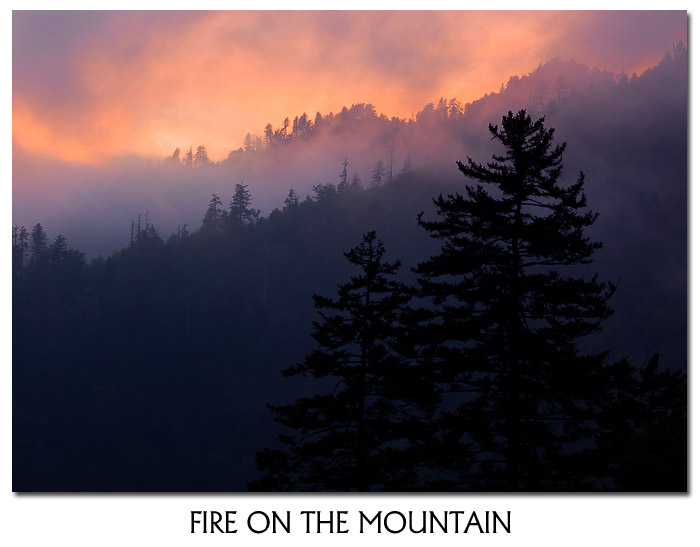Fire On The Mountain |
Nature and landscape photography is as much about being at the right place at the right time as it is about composition, depth-of-field, shutter speeds, or any of the other conventional mechanisms that go into making a photograph. Light is ephemeral and fleeting, as are the seasons, human emotions, and where we happen to be sitting or standing at any one given moment. The tenuous intersection where place and time converge is where the photographer tries to be, or at least anticipates being, in order to capture a singular, evanescent moment in nature that stirs the soul.
Instead, we nature photographers often find ourselves at the right place but wrong time or the right time but wrong place. Like a slow-witted mallet driver in a game of cosmic Whac-A-Mole, we're seemingly always a step or two behind the elusive light, or worse yet, perpetually guessing wrongly. Desperation soon sets in and one day you're muttering about why you didn't take up something less psychologically taxing such as bird watching.

Yet this was my mindset on day four of a five-day photography trip to the Great Smoky Mountains National Park a few years ago in late June. I was none too jazzed about my rather pedestrian portrayals of mountain streams and forest intimates taken during noonday cloud cover, and although there was some excellent light each sunset after the early evening thunderstorms rolled through, I had little to show for it. The transitory and unpredictable nature of clearing storm clouds, fog, and mist left me either socked in on some high, windy ridge or it was clear-sky city – all while a technicolor sky was on exhibit not too far away.
On day five, I had car trouble: something to do with an alternator, but I don't quite remember exactly. The weather pattern that day was identical to those previous: temperatures in the 80s, humidity, clouds in the afternoon, a passing thunderstorm. If the accepted script was to be followed, there should be clearing just before nightfall. But what to make of my inert car now taking up space in a Cherokee service station? Meet Bynum.
Bynum is a local mechanic, probably in his upper thirties, thin, red hair and beard, wearing blackish-gray acid wash jeans and a fluorescent green Ghostbusters tee shirt. He's just delivered the disappointing news. The part my car needs won't be in until Monday and considering it's Saturday, I'll likely miss out on any shot at a sunset that evening.
Bynum, however, is curious about my high-tech-looking photo gear and says he likes pretty pictures as much as anyone, so he offers to drive me up the mountain to watch me do what I do. He says he has no plans and he's more than happy to oblige. I reluctantly accept.
During our drive to Newfound Gap, I vent a little about my frustrations over the previous few days. He seems to understand.
"Well, ya know what the Chinese say about these sorta things, don't ya?" Bynum asks in this thick mountain twang.
I just stare at him without a reaction.
"When the water's high, the fish feast on the ants. But when the water's low, the ants feast on the fish."
He looked at me for a reaction, smiled, then we both began to laugh. We didn't speak again until we arrived at the top of the mountain.
As mist rose from the high mountain ridges and the sky was transformed into fire, it appeared as if the tide had indeed turned and it was my time to do the feasting. Bynum watched from a respectable distance with a fixed expression of bliss across his face.
We stayed well past dark and I photographed the changing light until the last shade of color faded from the sky.
This essay is an excerpt from Richard's just-released eBook
Great Smoky Mountains: Behind the Lens
Comments on NPN nature photography articles? Send them to the editor. NPN members may also log in and leave their comments below.
 NPN Editor-in-Chief, Richard Bernabe has been a full-time professional nature photographer and writer since 2003. He's had thousands of publishing credits in books, magazines, and calandars and regularly leads photography tours and workshops all across the United States and internationally in places like Patagonia, Iceland, and Peru.
NPN Editor-in-Chief, Richard Bernabe has been a full-time professional nature photographer and writer since 2003. He's had thousands of publishing credits in books, magazines, and calandars and regularly leads photography tours and workshops all across the United States and internationally in places like Patagonia, Iceland, and Peru.
For more information about Richard's photography, be sure to visit his personal website, Richard Bernabe Photography.
